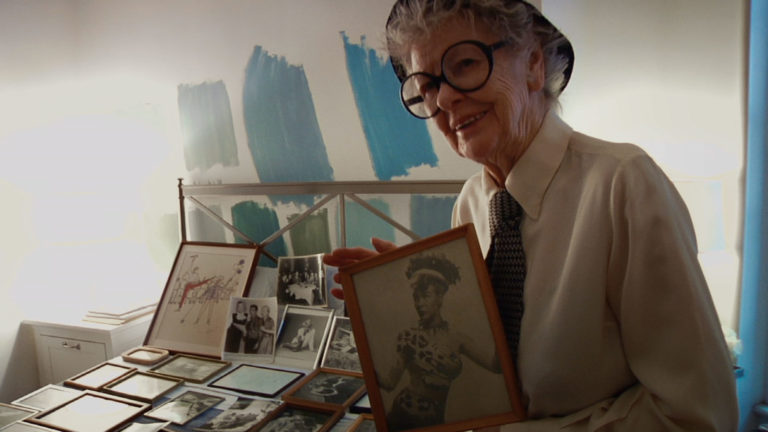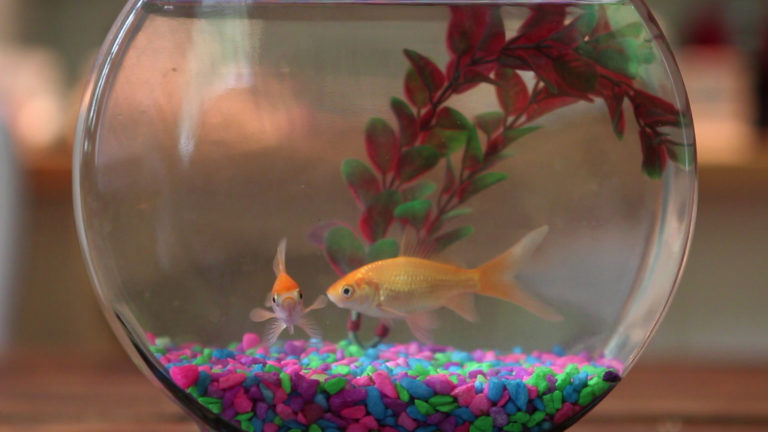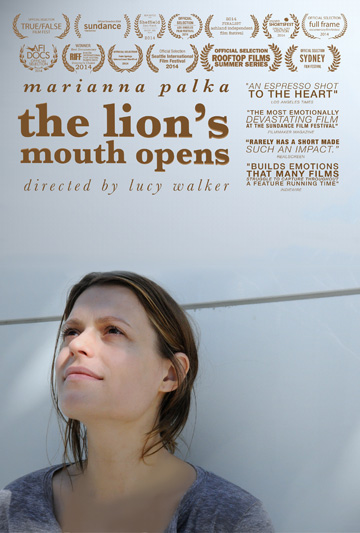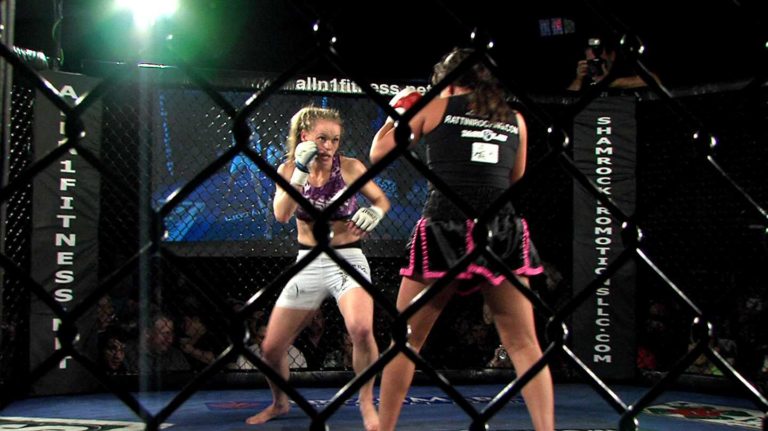At 87, Broadway legend ELAINE STRITCH remains indisputably in the spotlight. In the revealing and poignant ELAINE STRITCH: SHOOT ME, the uncompromising Tony and Emmy Award-winner is showcased both on and off stage via rare archival footage and intimate cinema vérité. By turns bold, hilarious and moving, the film’s journey connects Stritch’s present to her past, and an inspiring portrait of a one-of-a-kind survivor emerges. In stolen moments from her corner room at New York’s Carlyle Hotel and on breaks from her tour and work, candid reflections about her life are punctuated with photographs from her personal collection and words from friends (including Alec Baldwin, Hal Prince, George C. Wolfe, Nathan Lane, Cherry Jones, Tina Fey, James Gandolfini and John Turturro). Whether dominating the stage, tormenting Alec Baldwin on the set of “30 Rock,” or sharing her personal takes on her struggles with aging, diabetes and alcoholism, ELAINE STRITCH: SHOOT ME reaches beyond the icon’s brassy exterior and reveals a multi-dimensional portrait of a complex woman and artist. ELAINE STRITCH: SHOOT ME marks the directorial debut of acclaimed documentary producer Chiemi Karasawa
Summary info for schedule – will be hidden on film page
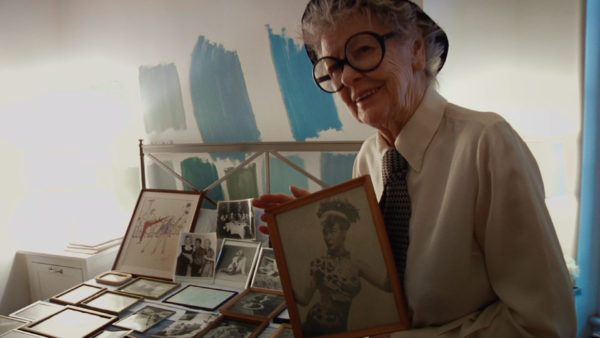
Elaine Stritch: Shoot Me
81-minutes
Screening day / time
Elaine Stritch: Shoot Me
Elaine Stritch: Shoot Me
Filmmaker Notes:
ABOUT ELAINE STRITCH: SHOOT ME Getting your hair done rarely leads to making a movie. But in 2010, filmmaker CHIEMI (“Chee-em’-ee”) KARASAWA leaned over to her hairdresser (and, later, Associate Producer), PIET SINTHUCHAI at the Vartali Salon in Midtown Manhattan and asked, “Is that ELAINE STRITCH?” Indeed, Broadway icon spotted. Karasawa had been working as a script supervisor for 15 years with directors like Martin Scorsese, Stephen Frears, Sam Mendes, Spike Jonze and Jim Jarmusch on numerous feature films and television projects. But by 2006, the time had come to branch out on her own as a producer, forming her own production company, Isotope Films. “I had established so many relationships by that time that it was easier to make the transition into producing,” she recalls. The company’s first documentary, “Billy the Kid,” hit the festival circuit in 2007, winning Best Documentary awards at South by Southwest, Los Angeles Film Festival and elsewhere. “I became hooked on documentary, versus narrative film,” the producer says. “I loved the fact that you could put a camera on somebody and not have had to raise millions of dollars to do it.” Karasawa had actually met Stritch in 2005 while working on John Turturro’s musical comedy, “Romance & Cigarettes,” in which the actress played James Gandolfini’s mother. But it was her visit to the salon, and query about Stritch, that prompted Sinthuchai to suggest his longtime client to Karasawa as her next documentary subject. Herself not a musical theater aficionado, the producer began researching Stritch’s history on the internet and immediately found herself captivated. “When I really reached into her history and realized the extent that she had been involved in the American theater – with people like Noel Coward, Tennessee Williams and Stephen Sondheim – I thought, ‘How is it possible that this woman is not a household name?’” Karasawa – like all fans of Stritch’s – was also smitten by something else. “Not only is she incredibly talented and prolific – but what a character. She is a fascinating, singular personality. And she was still at it.” Inspired, she pressed Sinthuchai to make a proper introduction. Eventually, in the summer of 2010, when Stritch was doing a show called “A Little Night Music,” Karasawa was indeed formally introduced during yet another visit to Vartali, and the two chatted about the idea – though things didn’t exactly come together immediately. “She told me to call her, then she’d forget that she told me to call her and not know who I was when I called,” she laughs. “There were a lot of false starts where I was being reprimanded for doing what she told me to do. I was quite intimidated by her.” But the producer persisted. It wasn’t until Vartali’s owner/partner, Houri Geudelekian, invited her to a dinner party – and seated Karasawa next to Stritch’s longtime musical director, ROB BOWMAN. “I told Rob about the idea, and he said, ‘Oh, she’d love to do that!’ But I explained that I’d been trying to talk to her about it for about five months, and that I was about to give up.” Bowman, though, was immediately taken with Karasawa’s sincere interest in Stritch. “I fell in love with her immediately – it’s hard not to,” he recalls. “I didn’t know why Elaine had kept waiving her off, but I could tell how much Chiemi wanted to do it. I told her, ‘I hope it could work out, because I would sure love people to see Elaine as I see her.’” Within a week, Karasawa heard from Stritch. “Sure enough, I got a call on my office phone – she left a message at, like, 2 a.m. – introducing herself – and saying, ‘I would LOVE to do this film with you. We’re gonna make this work. Let’s all go to dinner and we can talk about it.’” As Bowman recalls, “We all got together – it was about eight of us at the table – and Elaine just dug her. She liked Chiemi’s energy and just said, ‘Okay, I’m in. What do you want me to do?’” FILMING AN ICON Many documentaries about entertainment icons are filled with clips from movies and television broadcasts, used to illustrate the performer’s life and career, interspersed with interviews with friends or historians explaining them. But Karasawa decided to take a different tack, leaving behind the usual “carriage-to-casket” approach. “It’s much more interesting doing a verite film about a person like this while they’re still alive,” she notes. “Especially someone like Elaine.” Aside from the fact that licensing clips was far beyond the reach of an indie doc budget, it quickly became clear to the director that whatever Stritch was busy doing today was as equally valid as whatever she had done previously in her career. “After spending even a small amount of time with Elaine Stritch, I became more interested in following her in her day to day life, just exploring what it was like to be someone at her age, still working, very solidly, as a performing artist.” Whether it’s playing a recurring role on “30 Rock” as Alec Baldwin’s mother, doing seven shows a week in “A Little Night Music” or fielding calls from her agent at night on the phone in her room at the Carlyle, Stritch, she found out, was inherently interesting to watch and be around. “Even at this age, she’s still in full force.” But something else quickly became apparent, as well. “During that, sort of, ride of following her day to day life, I discovered she had Type 1 Diabetes and was much frailer than one would imagine, given her personality. She needs to be very regimented with her insulin and blood sugar control. She also presents herself as a recovering alcoholic, though, after 22 years of sobriety, now has a philosophy of having one drink a day, which was interesting. I was fascinated by her resolve to want to stop at times, but also learning that ultimately it’s her own decision. And at 88, she has every right to choose. It’s her right to live the rest of her life however she likes, and that can be hard for some people to accept, but that’s life.” The experience came with an important lesson. “Artists are complex people – you have to accept the whole person. Elaine is unashamed to tell you what she thinks, is unashamed to have an unpopular opinion. She’s someone who has weaknesses like we all do, but the remarkable thing about her is, she’s honest about herself. It’s something I learned a great deal about being around her.” The film doesn’t spend lengthy amounts of time focusing on the issue. “It would have been very easy to have made a sensational film about an alcoholic. But at the end of the day, if I get to present a film that’s going to be 90 minutes about somebody’s life, I’m not going to spend it all on alcoholism if it’s about Elaine Stritch. It doesn’t sum up all that she is.” Karasawa does skillfully weave in some choice films clips, along with rare stills from Stritch’s own archive – beginning the film with this curiously infectious personality who may not even be well-known to the audience, and slowly revealing her history, leaving the audience with their mouths agape with her accomplishments and acquaintances. “That’s how she revealed herself to me,” the director states. “That’s what the process of getting to know Elaine was like for me, as well.” The photos from Stritch’s collection were something Karasawa was anxious to sink her teeth into, knowing their review would prompt countless stories from their owner – about everything from Broadway shows, movies, family stories, her relationship with her late husband, actor John Bay, and even dates with a young John F. Kennedy – for whom she was unwilling to break her virginity, as she reveals in the film. “Elaine had had these boxes shipped from storage, and was going to select some photographs to be used at a studio being dedicated to her at the Stella Adler Studio,” of which Stritch is a renowned alumnus. “I kept asking her, ‘Is this the week you’re going to unpack the archives? We really want to shoot that.’ I knew that that day would be a really special one for us. It provided a spine for the film.” Those stories would be augmented by countless others Stritch would pop out, sometimes simply during an evening’s visit when she and Karasawa would sit and watch an old movie together on Turner Classic Movies. “You’re watching a film with her, and she’ll have ‘dated this guy’ and ‘was buddies with that guy,’ and tell you stories about the producer, or ‘we went to his summer house.’” Adds Bowman, “She doesn’t realize the importance these stories have to the rest of us. There’s so much to learn from this woman, and we’re all hungry for it.” ELAINE STRITCH: SHOOT ME was filmed over a fairly lengthy period – nearly a year and a half, from February 2011 to July 2012. Karasawa would typically meet with Stritch accompanied solely by a single cameraman, with no boom operator interfering with the star’s activities or comfort. “I never used a sound person,” she states. “I just put a lavaliere microphone on her. It would have been too much going on and too intrusive.” The majority of the vérité-type coverage of Stritch’s daily activities was shot by cameraman SHANE SIGLER, though several others, including Rod Lamborn and Josh Weinstein, were also used. “She would call me up at one in the morning and say, ‘Chiem, it’s Elaine. I’m feeling kind of chatty – you want to come on over and bring your camera?’ So I had to have a cameraman pretty much available whenever I got a call from her.” “I think there were actually about four or five guys that worked on the film,” Sigler recalls. “We’re all freelance, and we all have to work on other jobs, so Chiemi had had to struggle sometimes to find someone. I know it was hard on her. In some cases, she had to shoot things herself, which worked out well, too.” A call from Karasawa could arrive at any time, following notice that Stritch was heading off, say, to a doctor visit, along with an invitation to come along. “When we got those calls,” says Sigler, “to rush up to the Carlyle, where she lives, you just pretty much have to drop everything and go. It’s part of being a documentary filmmaker.” That comfort level, of having the petite Karasawa and her trusty cameraman toting a Panasonic HPX-170 camera on his shoulder following her every move, took time to build, as did her understanding of the process itself. “I still don’t think she knows what a documentary is,” the director chuckles. “I said to her, ‘We’re just going to observe you,’ and she went, ‘What are you talking about?? What do you want me to do?’ I just told her, ‘I want you to live your life.’” “There was a learning curve,” Sigler says. “She was a willing participant, but there was certainly a period of her coming to understand how we worked and us understanding her parameters and her boundaries. The more time we spent together, the smaller those boundaries became. We became so comfortable with each other, it just felt like, in so many ways, we were just hanging out with her – just having a conversation, almost as if the camera wasn’t there” – indeed, one of the most remarkable qualities of the film. As Bowman observed, “At first, she would have some event and Chiemi would ask to come, and sometimes, after saying yes, Elaine would change her mind. But as she got more comfortable with having them around, she got to a place of ‘Why not have them here as much as they want to be?” “I’m not quite sure when that transition occurred,” Karasawa adds. “In the beginning, it was, ‘I told you to call at this hour. Don’t call at this hour.’ And the next time I turn around, she was, like, ‘Can you hang this bra up for me, Honey?’ It was literally that shockingly quick.” The team captured everything in Stritch’s life, from the mundane – such as walks to the Theater District and visits to the eye doctor – to the set of “30 Rock,” filming a scene with Alec Baldwin for season six’s “Meet the Woggles” (which aired in April 2012), to live performances at various venues with Bowman leading an orchestra behind the performer, as well as rehearsals for those shows. Notes Sigler, “Any time Elaine goes out in the world, it’s an event. It always reveals something interesting about her.” A simple walk down the street or a ride down an elevator (singing show tunes with the elevator operator, of course) never failed to be a source of entertainment. “We would walk down the street, and a cyclist or a cab driver might swerve a little too close for her,” says Karasawa, “and she’d let them know. You think, ‘Oh, here’s this little old lady,’ and the next thing, she’s telling them, ‘Easy, you son of a bitch!’ That’s literally every day,” she laughs. “And she does that whether the camera’s there or not.” At first, one might think that Stritch’s behavior on camera is indeed for the camera, though Bowman assures that is not the case. “In the beginning, she might have had a little of that, but it disappeared pretty quickly,” says Stritch’s musical director of 13 years. “It’s really just something built into her, to perform. She has this element of ‘I have to deliver’ – even with people on the street. She has this strong desire to satisfy everybody, to give them what they want.” Karasawa agrees. “I think performing is so ingrained in her personality that she doesn’t feel like anybody is getting their money’s worth unless she can make them laugh – even if you’re just hanging out in her room. It’s just who she is – she’s a born performer. She’s entertaining simply by virtue of the fact that she’s Elaine Stritch.” Stritch also wasn’t afraid to tell the cameraman what to do, visible in one scene in which she begins directing camera operator Rod Lamborn on how to capture the shot she thinks he ought to have. “That happened very early on in the shoot,” Karasawa explains. The director was in Toronto for the opening of her film, “Love, Etc.,” when she received a call from Stritch inviting her to film a rehearsal. ”I sent a cameraman over there to be a fly on the wall – it was like sending a lamb to slaughter. He had no idea what he was getting himself into. I spoke to him later that night, and he just said, ‘You didn’t tell me who this woman was. . . She was trying to direct the scene.’ It was as typical Elaine as she gets. If somebody isn’t acting in charge of what they’re doing, then she’s gonna be in charge of what they’re doing.” Sigler had a similar experience on the shoot’s very first day, filming Stritch while she looked over a contract in her Carlyle rehearsal room – and telling him his lens was a little too close for comfort (“Unless this is a skin commercial,” she quips). “When you’re shooting a documentary, sometimes it’s hard to know where to draw the line,” he notes. “But the other part of it is, Elaine has been in front of movie and television cameras her whole life. She certainly has a sense about what the lens is seeing.” The flip side of the coin was also true. “There were plenty of times she was traipsing around with little or no clothes on,” the director laughs, “and she didn’t want the cameraman out of the room.” Adds Sigler, “That’s something that’s not uncommon backstage in theater. But she also is someone who’s not ashamed of her body, and she’s quite comfortable with herself.” Karasawa and Sigler were also witness to less comfortable times, such as when Stritch would experience a hypoglycemic attack, appearing immensely distressed and upset, as can sometimes happen with a diabetes patient in such instances. While most documentary subjects would have given a sharp “Turn that off!” order to the cameraman, Stritch was just the opposite. “I have footage of her saying, ‘Did you get that? That was a bad moment! That’s good for you,’” the director recalls. “She understood that any event in her life was going to be an event for us. To her, this was just the life she’s living. She doesn’t think of anything being more exciting than other things. It’s just what she goes through. And she wanted to be very honest about it.” Stritch also wasn’t averse to hiding her issues with her memory, as seen in the film as she struggles to learn lyrics to new songs, frustrated during rehearsals at her inability to pick up lyrics as quick as she once had. “It’s actually an effect of her diabetes – it comes with a price,” Bowman explains. While Stritch becomes quite emotional during such rehearsal sequences, the film also reveals her uncanny level of showmanship, when the same thing happens during performances, busking with Bowman onstage in a seemingly fun manner to get through a song. “She has this incredible way to work it in, to the point that people think it was part of the show,” he explains. “It just becomes this incredible piece of ad libbing. Adds Sigler, “It was amazing watching her do that – she would struggle, but deal with it in a way that she came out on top. She’s so brilliant in that way.”Karasawa also experienced a wonderful side to spending so much time with Elaine Stritch. “She likes people in her life,” she notes. “And if you’re going to hang out with her, you immediately become very useful to her. She has to go to the doctor or go to a meeting, she’ll call and ask, ‘Can you come? Are you around? Sure, bring the camera.’ As her good friend in the film, Julie Keyes, says, with Elaine, ‘There are tasks involved,’ particularly in being a woman of her age that lives alone.” There was a wonderful side effect that came with all that hanging out. “She and I became close. I had a lot of personal issues that year, both with my family’s health, love-life and other things, and she became a real confidante and friend. And I became hers.” “They really clicked,” adds Bowman. “Elaine cherishes her friendships. She enjoys being with people that she cares a lot about. It’s not just a matter of taking her to the doctor’s. It’s going from Point A to Point B – you’re along for the ride with her.” Once Karasawa found herself “on the inside,” she found she was a member of a small group of people that watched out – and continue to – for Stritch. “There are four or five people that are very close to her now. We all keep in touch with each other about what’s going on with her, because it takes all of us to understand the full picture of what’s going on in her life, medically and otherwise.” Growing close to Stritch seems to have an odd effect, though, on her friends – it becomes impossible to quote her without. . . sounding like her, with her unique, gruff, powerful voice. “When I was interviewing Alec Baldwin, we both started going into our Elaine Stritch voices to each other,” Karasawa laughs. “He would imitate her talking to the producers on the set of ’30 Rock,’ saying, ‘John, I don’t know where I am right now! What are we doing??’ I told him, ‘She does that even when she’s not on ’30 Rock’ She says it to me all the time -‘Chiem, what is going on here? What am I supposed to be doing??’” It doesn’t appear it will be something that will wear off anytime soon, as viewers of ELAINE STRITCH: SHOOT ME will also find. “She has this infectious thing about her – it’s like a disease. Once you’ve spent enough time around her, all you want to do is hear her tell stories and talk about funny things that happen when she’s around. Elaine is a singular personality. She’s always interesting, even when she’s not trying to be.” ELAINE STRITCH: A TIMELINE 1925 – Elaine Stritch is born in Detroit, Michigan. 1942 – Ms. Stritch arrives in New York. 1946 – Ms. Stritch makes her Broadway debut in Loco. It closes after 37 performances. 1947 – Ms. Stritch makes her debut on the musical stage in Angel in the Wings. 1950 – Ms. Stritch stands by for the legendary Ethel Merman in Call Me Madam. She is later chosen to head the national tour. 1952 – Ms. Stritch appears in the revival of Pal Joey, stopping the show cold with her second act striptease, “Zip.” 1956 – Ms. Stritch is nominated for her first Tony Award for originating the role of Grace in William Inge’s Bus Stop. 1956 – Ms. Stritch has her first featured film role in the Michael Curtiz’ noir, The Scarlet Hour. 1957 – Ms. Stritch stars in Charles Vidor’s A Farewell to Arms. The film grosses a then staggering 25 million dollars. 1961 – Noel Coward writes Ms. Stritch a featured part in his new musical, Sail Away. Ms. Stritch’s work is so well received that the leading lady is fired and Ms. Stritch assumes her role. 1962 – Ms. Stritch replaces Uta Hagen in Who’s Afraid of Virginia Woolf, beginning a decade’s long association with the playwright Edward Albee. 1970 – Ms. Stritch creates the role of Joanne in Stephen Sondheim and George Furth’s seminal musical, Company. She introduces the song “The Ladies Who Lunch,” which becomes her signature number. 1973 – Elaine Stritch marries actor John Bay. Their union lasts 10 years, until Mr. Bay’s death in 1982. 1975 – Ms. Stritch co-stars stars with Donald Sinden in the smash hit, British television program Two’s Company, earning multiple BAFTA nominations. 1977 – Ms. Stritch holds her own against John Gielgud and Dirk Bogarde in Alan Resnais’ much-acclaimed film, Providence. 1987 – Ms. Stritch stars as Mia Farrow’s glamorous movie star mother in Woody Allen’s September. 1993 – Ms. Stritch wins an Emmy Award for her recurring role as feminist attorney Lainie Stieglitz on Law & Order. 1994 – Ms. Stritch returns to the New York stage in Hal Prince’s revival of Show Boat. 2001 – Ms. Stritch’s one-woman show Elaine Stritch at Liberty premieres at the Public Theater, later transferring to the Neil Simon Theatre on Broadway and later to the West End. She receives a Tony Award and an Emmy Award for her work in the show. 2002 – Ms. Stritch moves into Suite 309 at the Carlyle Hotel. 2007 – Ms. Stritch is awarded an Emmy for her role as Alec Baldwin’s mother on 30 Rock. She plays the part to wild acclaim for the next seven years. 2009 – Ms. Stritch appears with Bernadette Peters in the revival of Stephen Sondheim’s A Little Night Music, replacing original stars Angela Lansbury and Catherine Zeta-Jones. Their engagement is extended twice. 2013 – Elaine Stritch performs her farewell Cabaret engagement at the Café Carlyle -Elaine Stritch at Home at the Carlyle: Movin’ Over and Out
